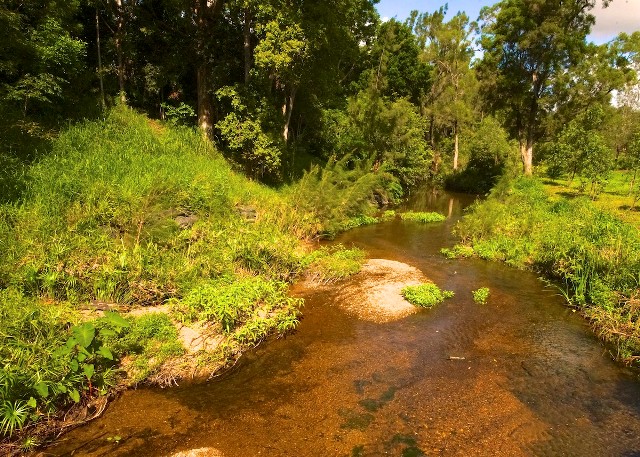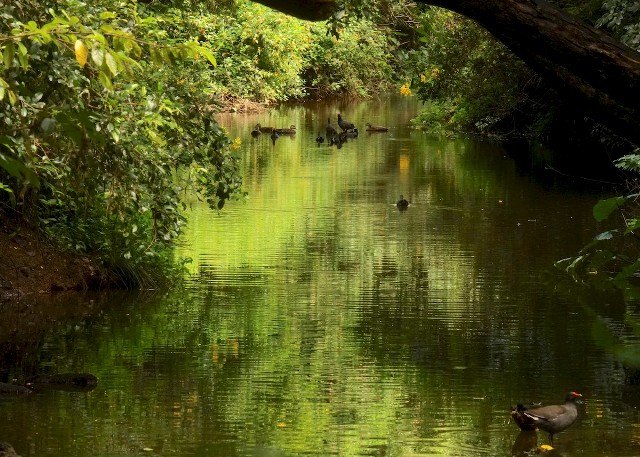In the upper reaches of Moggill Creek and most of Gold Creek there are very few “Water Weeds”, but the same is not true of the lower reaches of Moggill Creek.
Water weeds need two things to prosper – light and nutrients.
In the upper reaches the creeks are mostly covered by vegetation. Some are native trees and there are some areas with a fair number of exotics such as Privet, Camphor Laurel and Chinese Elms, but they all contribute to the shade over the creek.
 |
|
An open area along Moggill Creek at Tuckett’s Farm with several different water weeds. |
The fertility of our creeks increases as they descend through areas of open paddocks and past houses and then by large establishments such as the Brookfield Retirement Village. The run-off from paddocks with livestock,from roads, and from seepage from septic systems results in increased phosphates and nitrates in the creek water.
By the time it gets past the junction of Gold Creek and Moggill Creek the water has picked up substantial levels of nutrients and in times of low water flow can be quite turbid.
Added to this, the clearing of the banks of the creek in some areas along the lower Moggill Creek has in effect supplied all the nutrients and light required for the growth of water weeds.
These nutrients have to go somewhere! They are either flushed out into the Brisbane River in strong creek flows, result in dense algae growth or they promote the growth of water weeds.
 |
|
This photo is of two large water holes that were part of the Dart Farm. |
The choices of how to handle this depends on what amenity is desired.
It is very difficult to stop these nutrients entering the creeks. We cannot expect all the residents to return their paddocks back to native bush, nor can we close down the retirement village.
We could allow the water weeds to do their job of using up the nutrients or plant more efficient water plants along the creek in artificial wetlands to strip out the nutrients. This would would be better than algae blooms that contribute to the turbidity or worse, mats of stringy algae.
The other alternative is to replant the edges of the creek to reduce the light levels so the water plants won’t grow. This approach would rely on the creek flooding to flush out the fertile nutrient-rich water into the Brisbane River. Unfortunately this only works in big floods and small creek flows actually increase the fertility by washing the nutrients from the paddocks into the creeks.
In the meantime we probably have to accept that most of the “Water Weeds” we have in the creeks are probably doing a good job for us in reducing the nutrients in the creeks
We do need to be vigilant, however, as we do have some Elodea (Egeria densa) in the Moggill Creek. It is a fully submerged weed and is renowned as the weed that clogged up the Hawkesbury River in NSW. It will be washed out in really big floods, but can clog up the creeks in low flows.
Unfortunately it is not a noxious weed in Queensland and Victoria and it is often planted in fish ponds and farm dams and can be washed into the creeks during heavy rainfall periods.
There are very few native water plants that are adapted to water with substantial phosphorus levels. Those natives that are capable of handling the high nutrient levels can often grow so rampantly that they become weeds themselves. Bullrushes and Hydrilla are examples.
Some natives that will assist a little are Twig Rushes (Baumea spp.), Club Rushes (Bulboschoenus spp.), some Flat Sedges (Cyperus spp.), Spike Rushes (Eleocharis spp.) and Sedges Rushes (Juncus spp).
Avoid planting waterlilies, especially the yellow flowered Nymphaea mexicana (N. flava) which some years ago was a rampant weed in Gold Creek. Waterlilies have little effect in reducing the nutrient levels in the water.
Overall, however, we are very lucky in the Moggill Creek Catchment as we have some of the best vegetated and best water quality creeks in Brisbane!

